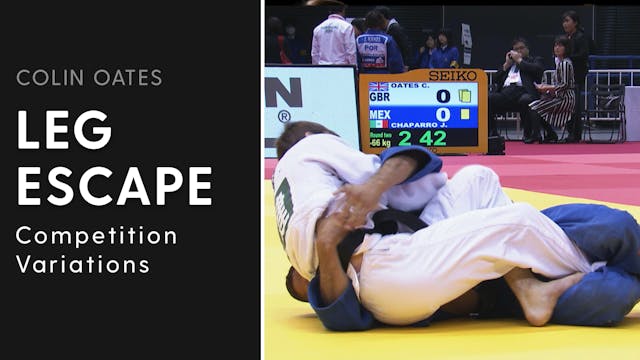Colin Oates used Sumi Gaeshi not only as a way to score from standing, but as his primary method of initiating Newaza. His leg escape into Mune Gatame worked hand-in-hand with his Sumi Gaeshi. So much so that Oates would regularly attack with Sumi Gaeshi with the intention actually being to set-up his leg escape, rather than to score.
He says that in the latter part of his competitive career, if he got to the point where he had his opponent flat on their back, with his leg trapped, he felt he had a 75% chance of winning the contest. He regarded this as his ‘winning position’.
From a failed Sumi Gaeshi attack and in guard position, Oates reaches over his partner’s far shoulder with his left arm, taking their belt. He then comes under their armpit with his right arm, securing the top half of their body.
Oates points out that tempo, maintaining control and pressure are the three key components to making this technique a success. The tempo must be as quick as possible when gripping the belt and under the armpit. Once he has control he slows everything down as he climbs up on top of his partner and starts to work his leg out.
As he kicks the leg out, he goes back to full speed, spinning into the hold-down. The transition from standing into groundwork, and to having both hands on is fast. Now everything slows down as Oates takes control and starts building pressure. He does this by leaning and squeezing against his partner’s head, which he says is the most uncomfortable position for them to be in as they are fighting to breathe.
It’s the continual pressure that forces his opponent to release the leg, with their attention shifting from their legs to their head. A slow tempo means technique control and a build-up of pressure. But at the point you manage to escape the leg you must be as quick as possible, because this is the moment Uke will put everything into trying to roll and escape.
Another key point is to make sure that the partner’s body position changes from being on their back to their side. As control of the upper body must be maintained through both belt and armpit grip, this movement should be performed by the lower half of the body, using a shrimping action. This shrimping can also be used to help work the leg away from your partner’s, to the point at which it can be freed.
Once in Mune Gatame Oates says not to drop your weight and hold too tightly. If you do you will find that you are attached to your partner. And if they attempt to roll out, you may find you are going with them. Instead Oates likes to stay relaxed and give a bit of space between his partner’s chest and his. His left arm is free and mobile. It’s used to brace against attempted escapes and to counter big movements from the partner.
He says that this space gives the partner the impression that there is a way to escape. But all it ends up doing is sapping their energy, until eventually they give up.
Up Next in Leg Escape
-
Tie Off Variation | Leg Escape | Coli...
Sometimes Colin Oates’s opponents would catch the leg far too tightly for him to free it in his usual manner. So he developed a tie off variation of his leg escape into Mune Gatame, so that he wasn’t trying to free the leg using his lower body alone.
If the partner has managed to keep a tight gr...
-
Reverse Variation | Leg Escape | Coli...
When opponents became familiar with Colin Oates’s leg escape they would start bringing their arm in tight to their body, to prevent him from going under their armpit. So he developed a reverse variation, prising their elbow up and entering from the opposite direction.
Once inside, he secures th...
-
Competition Variations | Leg Escape |...
In this clip we will look at competition variations of Colin Oates’ leg escape
On his way to the bronze medal at the 2014 Samsun Grand Prix, Colin Oates defeats Georgia’s Tatarashvili using his leg escape after a failed drop Seoi nage attempt by his opponent.
As Oates tries to release the leg, ...



